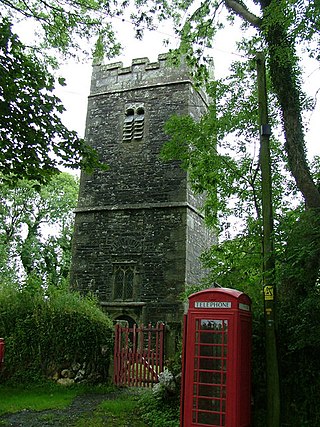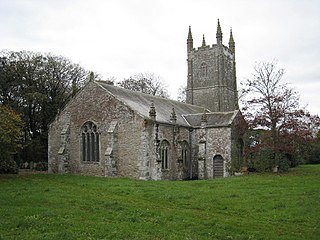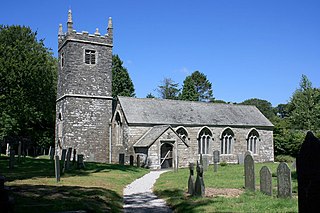
The Cathedral of the Blessed Virgin Mary is a Church of England cathedral in the city of Truro, Cornwall. It was built between 1880 and 1910 to a Gothic Revival design by John Loughborough Pearson on the site of the parish church of St Mary. It is one of only three cathedrals in the United Kingdom featuring three spires.

St Bartholomew's Church is a parish church of the Church of England Diocese of Truro in Lostwithiel, Cornwall, England, United Kingdom.

St Veep is a civil parish in Cornwall, England, United Kingdom, situated above the east bank of the River Fowey about three miles (5 km) south-east of Lostwithiel. It is bordered by the parishes of St Winnow to the north-west, Boconnoc to the north, Lanreath to the east Polperro to the south-east and Lanteglos to the south. The River Fowey forms its western boundary. The parish is named after Saint Veep of whom little is known.

The Church of St Buryan is a late-15th-century Church of England parish church in St Buryan in Cornwall, England.

The parish Church of St. Quiricus and St. Julietta in Tickenham, Somerset, England, has 11th-century origins, with the nave and chancel being extended by the addition of aisles and the south chapel in the early 13th century. It has been designated as a Grade I listed building.

St Edmund's Church, Southwold is a Grade I listed parish church in the Church of England in Southwold, Suffolk.

St Ildierna's Church, Lansallos is a Grade I listed parish church in the Church of England in Lansallos, Cornwall, built in the early 14th century. The church is noted for its 16th-century benches and bench ends. Serious damage was caused to the church, especially the roof, by a fire in 2005.

St Mary Magdalene's Church, Launceston is a Grade I listed parish church in the Church of England in Launceston, Cornwall. It is unusual for its carvings; the entire exterior of the original part of the church is built of carved granite blocks. The church is dedicated to Jesus' companion, Mary Magdalene.

St Denis's Church, Otterham is a Grade II* listed parish church in the Church of England Diocese of Truro in Otterham, Cornwall.

St Gwinear's Church, Gwinear is a Grade I listed church in the Church of England in Gwinear, Cornwall.

St Gothian's Church, Gwithian is a Grade II* listed parish church in the Church of England Diocese of Truro in Gwithian, Cornwall, England, UK. Nothing is known about St Gothian, Gocianus or Gwithian.

St Ladoca's Church, Ladock, is a Grade I listed parish church in the Church of England Diocese of Truro in Ladock, Cornwall, England, UK.

St Hermes’ Church, St Erme is a Grade II* listed parish church in the Church of England Diocese of Truro in St Erme, Cornwall, England, UK.

Boconnoc Church is a Grade I listed Church of England parish church in Boconnoc, Cornwall.

St Martin and St Meriadoc's Church, Camborne is a Grade I listed parish church in the Church of England in Camborne, Cornwall.

All Saints’ Church, Tuckingmill is a Grade II listed parish church in the Church of England in Pendarves Street, Tuckingmill, Camborne, Cornwall.

St Brevita's Church is a Grade I listed medieval parish church of the Church of England in Lanlivery, Cornwall. The church was built in the 14th and 15th centuries in the Perpendicular Gothic style, and is dedicated to Saint Bryvyth, or Brevita. Bryvyth's veneration is unique to Lanlivery and nothing is known about her. The churchyard contains multiple monuments, listed separately from the church itself.

St Mary the Virgin’s Church, Braddock or Bradoc is a Grade I listed parish church in the Church of England in Braddock, Cornwall.

St Winnow's Church, St Winnow is a Grade I listed parish church in the Church of England in St Winnow, Cornwall.

St Columba's Church is a 14th-century, Grade I listed parish church in the Church of England Diocese of Truro in St Columb Major, Cornwall. In 1860 plans were drawn up by William Butterfield, in hope of St Columb church becoming the cathedral of the future diocese of Cornwall, but the cathedral was built at Truro. A second church dedicated to the same saint is known as St Columba's Church, St Columb Minor.






















